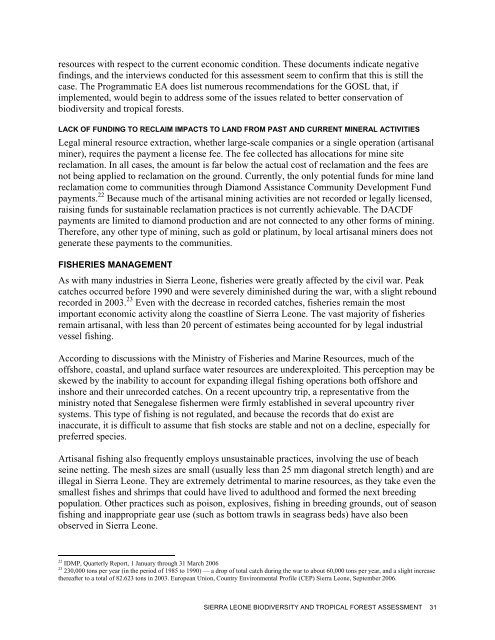118/119 Biodiversity and Tropical Forest Assessment for Sierra Leone
118/119 Biodiversity and Tropical Forest Assessment for Sierra Leone
118/119 Biodiversity and Tropical Forest Assessment for Sierra Leone
You also want an ePaper? Increase the reach of your titles
YUMPU automatically turns print PDFs into web optimized ePapers that Google loves.
esources with respect to the current economic condition. These documents indicate negative<br />
findings, <strong>and</strong> the interviews conducted <strong>for</strong> this assessment seem to confirm that this is still the<br />
case. The Programmatic EA does list numerous recommendations <strong>for</strong> the GOSL that, if<br />
implemented, would begin to address some of the issues related to better conservation of<br />
biodiversity <strong>and</strong> tropical <strong>for</strong>ests.<br />
LACK OF FUNDING TO RECLAIM IMPACTS TO LAND FROM PAST AND CURRENT MINERAL ACTIVITIES<br />
Legal mineral resource extraction, whether large-scale companies or a single operation (artisanal<br />
miner), requires the payment a license fee. The fee collected has allocations <strong>for</strong> mine site<br />
reclamation. In all cases, the amount is far below the actual cost of reclamation <strong>and</strong> the fees are<br />
not being applied to reclamation on the ground. Currently, the only potential funds <strong>for</strong> mine l<strong>and</strong><br />
reclamation come to communities through Diamond Assistance Community Development Fund<br />
payments. 22 Because much of the artisanal mining activities are not recorded or legally licensed,<br />
raising funds <strong>for</strong> sustainable reclamation practices is not currently achievable. The DACDF<br />
payments are limited to diamond production <strong>and</strong> are not connected to any other <strong>for</strong>ms of mining.<br />
There<strong>for</strong>e, any other type of mining, such as gold or platinum, by local artisanal miners does not<br />
generate these payments to the communities.<br />
FISHERIES MANAGEMENT<br />
As with many industries in <strong>Sierra</strong> <strong>Leone</strong>, fisheries were greatly affected by the civil war. Peak<br />
catches occurred be<strong>for</strong>e 1990 <strong>and</strong> were severely diminished during the war, with a slight rebound<br />
recorded in 2003. 23 Even with the decrease in recorded catches, fisheries remain the most<br />
important economic activity along the coastline of <strong>Sierra</strong> <strong>Leone</strong>. The vast majority of fisheries<br />
remain artisanal, with less than 20 percent of estimates being accounted <strong>for</strong> by legal industrial<br />
vessel fishing.<br />
According to discussions with the Ministry of Fisheries <strong>and</strong> Marine Resources, much of the<br />
offshore, coastal, <strong>and</strong> upl<strong>and</strong> surface water resources are underexploited. This perception may be<br />
skewed by the inability to account <strong>for</strong> exp<strong>and</strong>ing illegal fishing operations both offshore <strong>and</strong><br />
inshore <strong>and</strong> their unrecorded catches. On a recent upcountry trip, a representative from the<br />
ministry noted that Senegalese fishermen were firmly established in several upcountry river<br />
systems. This type of fishing is not regulated, <strong>and</strong> because the records that do exist are<br />
inaccurate, it is difficult to assume that fish stocks are stable <strong>and</strong> not on a decline, especially <strong>for</strong><br />
preferred species.<br />
Artisanal fishing also frequently employs unsustainable practices, involving the use of beach<br />
seine netting. The mesh sizes are small (usually less than 25 mm diagonal stretch length) <strong>and</strong> are<br />
illegal in <strong>Sierra</strong> <strong>Leone</strong>. They are extremely detrimental to marine resources, as they take even the<br />
smallest fishes <strong>and</strong> shrimps that could have lived to adulthood <strong>and</strong> <strong>for</strong>med the next breeding<br />
population. Other practices such as poison, explosives, fishing in breeding grounds, out of season<br />
fishing <strong>and</strong> inappropriate gear use (such as bottom trawls in seagrass beds) have also been<br />
observed in <strong>Sierra</strong> <strong>Leone</strong>.<br />
22 IDMP, Quarterly Report, 1 January through 31 March 2006<br />
23 230,000 tons per year (in the period of 1985 to 1990) — a drop of total catch during the war to about 60,000 tons per year, <strong>and</strong> a slight increase<br />
thereafter to a total of 82.623 tons in 2003. European Union, Country Environmental Profile (CEP) <strong>Sierra</strong> <strong>Leone</strong>, September 2006.<br />
SIERRA LEONE BIODIVERSITY AND TROPICAL FOREST ASSESSMENT 31

















